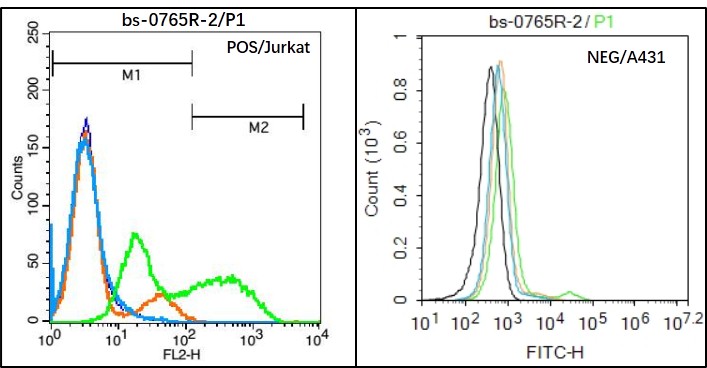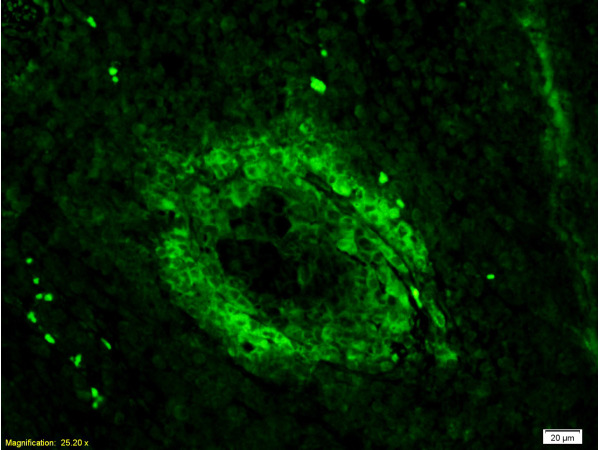
Jurkat (Positive) and A431 (Negative control) cells (black) were incubated in 5% BSA blocking buffer for 30 min at room temperature. Cells were then stained with CD3 epsilon Polyclonal Antibody (bs-0765R) at 1:50 dilution in blocking buffer and incubated for 30 min at room temperature, washed twice with 2% BSA in PBS, followed by secondary antibody(blue) incubation for 40 min at room temperature. Acquisitions of 20,000 events were performed. Cells stained with primary antibody (green), and isotype control (orange).
CD3E Polyclonal Antibody
BS-0765R
ApplicationsFlow Cytometry, ImmunoFluorescence, Western Blot, ELISA, ImmunoHistoChemistry, ImmunoHistoChemistry Frozen, ImmunoHistoChemistry Paraffin
Product group Antibodies
TargetCd3e
Overview
- SupplierBioss
- Product NameCD3E Polyclonal Antibody
- Delivery Days Customer16
- ApplicationsFlow Cytometry, ImmunoFluorescence, Western Blot, ELISA, ImmunoHistoChemistry, ImmunoHistoChemistry Frozen, ImmunoHistoChemistry Paraffin
- Applications SupplierWB(1:300-5000), ELISA(1:500-1000), FCM(1:20-100), IHC-P(1:200-400), IHC-F(1:100-500), IF(IHC-P)(1:50-200)
- CertificationResearch Use Only
- ClonalityPolyclonal
- Concentration1 ug/ul
- ConjugateUnconjugated
- Gene ID12501
- Target nameCd3e
- Target descriptionCD3 antigen, epsilon polypeptide
- Target synonymsCD3, CD3epsilon, T3e, T-cell surface glycoprotein CD3 epsilon chain, T-cell surface antigen T3/Leu-4 epsilon chain
- HostRabbit
- IsotypeIgG
- Protein IDP22646
- Protein NameT-cell surface glycoprotein CD3 epsilon chain
- Storage Instruction-20°C
- UNSPSC12352203
References
- Park M, Cho KA, Kim YH, et al. Lymphatic endothelial cells promote T lymphocyte migration into lymph nodes under hyperlipidemic conditions. Biochem Biophys Res Commun. 2020,525(3):786-792. doi: 10.1016/j.bbrc.2020.02.154Read this paper
- Li T, Wei Z, Sun Y, et al. Withanolides, Extracted from Datura Metel L. Inhibit Keratinocyte Proliferation and Imiquimod-Induced Psoriasis-Like Dermatitis via the STAT3/P38/ERK1/2 Pathway. Molecules. 2019,24(14). doi: 10.3390/molecules24142596Read this paper
- Sahiner IF, Soylu H, Ates E, et al. Impact of intravesical hyaluronic acid treatment on bladder inflammation in interstitial cystitis rat model. Int Braz J Urol. 2018,44(5):1014-1022. doi: 10.1590/S1677-5538.IBJU.2017.0713Read this paper
- Karaboga İ, Demirtas S, Karaca T. Investigation of the relationship between the Th17/IL-23 pathway and innate-adaptive immune system in TNBS-induced colitis in rats. Iran J Basic Med Sci. 2017,20(8):870-879. doi: 10.22038/IJBMS.2017.9108Read this paper
- Becher PM, Lindner D, Fröhlich M, et al. Assessment of cardiac inflammation and remodeling during the development of streptozotocin-induced diabetic cardiomyopathy in vivo: a time course analysis. Int J Mol Med. 2013,32(1):158-64. doi: 10.3892/ijmm.2013.1368Read this paper



